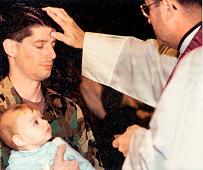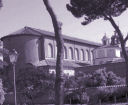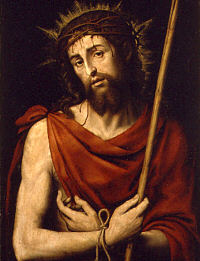We Can You Eat Meat Again Ash Wednesday
» Enjoy our Liturgical Seasons serial of eastward-books!
Other Commemorations: Ash Wednesday
Antiphon 1 and Responsory:
Let us modify our garments to sackcloth and ashes, let us fast and weep before the Lord, that our God, rich in mercy, might forgive the states our sins.
Let us correct our faults which we accept committed in ignorance, allow us not be taken unawares by the day of our death, looking in vain for leisure to repent. Hear us, O Lord, and prove united states of america your mercy, for we have sinned against you.
Pope Francis has everyone to participate in a Mean solar day of Fasting for Peace on this Ash Wednesday. Meet his Full general Audience on February 23, 2022 for more details.
Ash Wednesday, the Starting time of Lent:
The time has now come in the Church building year for the solemn observance of the great fundamental deed of history, the redemption of the human race by our Lord and Savior Jesus Christ. In the Roman Rite, the beginning of the twoscore days of penance is marked with the austere symbol of ashes which is used in today'due south liturgy. The use of ashes is a survival from an ancient rite according to which converted sinners submitted themselves to canonical penance. The Alleluia and the Gloria are suppressed until Easter.
For members of the Latin Catholic Church, the laws regarding forbearance and fasting are equally follows:
- Forbearance from eating meat is to be observed on Ash Wednesday and all Fridays during Lent. This applies to all persons xiv years of historic period and older.
- Fasting on Ash Wed and Expert Friday applies to all Catholics who have completed their eighteenth year to the get-go of their sixtieth year. A person is permitted to eat 1 full meal, as well every bit ii smaller meals that together are not equal to a full meal.
Station Church Data >>>
Ash Midweek
 At the start of Lent, on Ash Wednesday, ashes are blessed during Mass, later the homily. The blessed ashes are and so "imposed" on the faithful equally a sign of conversion, penance, fasting and human mortality. The ashes are blest at least during the outset Mass of the day, but they may also be imposed during all the Masses of the twenty-four hours, after the homily, and even outside the time of Mass to meet the needs of the faithful. Priests or deacons normally impart this sacramental, just instituted acolytes, other extraordinary ministers or designated lay people may be delegated to impart ashes, if the bishop judges that this is necessary. The ashes are made from the palms used at the previous Passion Lord's day ceremonies.
At the start of Lent, on Ash Wednesday, ashes are blessed during Mass, later the homily. The blessed ashes are and so "imposed" on the faithful equally a sign of conversion, penance, fasting and human mortality. The ashes are blest at least during the outset Mass of the day, but they may also be imposed during all the Masses of the twenty-four hours, after the homily, and even outside the time of Mass to meet the needs of the faithful. Priests or deacons normally impart this sacramental, just instituted acolytes, other extraordinary ministers or designated lay people may be delegated to impart ashes, if the bishop judges that this is necessary. The ashes are made from the palms used at the previous Passion Lord's day ceremonies.
—Ceremonies of the Liturgical Yr, Msgr. Peter J. Elliott
The act of putting on ashes symbolizes fragility and mortality, and the need to be redeemed by the mercy of God. Far from being a simply external act, the Church has retained the apply of ashes to symbolize that attitude of internal penance to which all the baptized are called during Lent.
—Directory on Pop Piety and the Liturgy
Meditation—An Itinerary of Conversion
The rediscovery of the baptismal character of Lent, the aboriginal penitential season that precedes Easter, and the restoration of the Paschal Triduum—Holy Th, Good Fri, and the Easter Vigil—as the apex of the Church'south liturgical twelvemonth are two of the virtually important accomplishments of modernistic Catholicism.
Over the centuries, the elevation of the Church'south year of grace—the commemoration of Christ's passing over from decease to life, for which the Church building prepares in Lent—had become encrusted with liturgical barnacles that gradually took center stage in the drama of Holy Week. And while some of them had a beauty of their own, such every bit the Tenebrae service, celebrated early in the morning of Holy Thursday, Good Friday, and Holy Saturday, the overall effect was to diminish the liturgical richness of the Triduum; the Easter Vigil's essential character as a dramatic night-spotter, when the Church gathers at the Lord'southward tomb to ponder the great events of salvation history while awaiting the vivid dawn of the Resurrection, was almost completely obscured. Similarly, Lent, which had an intensely baptismal grapheme centuries ago, became about exclusively penitential: a thing of what Catholics must non do, rather than a flavor focused on the center of the Christian vocation and mission—conversion to Jesus Christ and the deepening of our friendship with him.
Now, thanks to Pope Pius XII's restoration of the Easter Acuity and the liturgical reforms mandated past the 2nd Vatican Council, Catholics of the twenty-commencement century tin can celebrate both Lent and the Paschal Triduum in the richness of their evangelical and baptismal graphic symbol, as moments of intensified conversion to Christ and incorporation into his Body, the Church. Lent, one time dreaded, has become pop: churches are full on Ash Wed, and the disciplines of Lent—fasting, almsgiving, intensified prayer—have at present been relocated properly within the great human adventure of continuing conversion. Celebrated with appropriate solemnity, the Paschal Triduum today is what it should be: the apex of the liturgical year, in which those who were initially conformed to Christ in Baptism, along with those baptized at the Easter Vigil, relive the Master's Passion and Death in order to experience the joy of the Resurrection, the decisive confirmation that God's purposes in history will exist vindicated.
This revival of Lent in the Catholic Church has involved the rediscovery of the Forty Days as a flavour shaped by the catechumenate: the flow of education and formation through which adults who have not yet been baptized are prepared to receive Baptism, Confirmation, and the Holy Eucharist, the three sacraments of Christian initiation, at the Easter Vigil. The baptismal character of Lent is not for catechumens only, however. The adult catechumenate (chosen the Rite of Christian Initiation of Adults) offers an almanac reminder to the Church that allalways in need of conversion. The Church building'south conversion, the Church building'southward being-made-holy, is a never-catastrophe procedure.
Baptism, the Scriptures tell us, is "for the forgiveness of sins." And while that cardinal aspect of the sacrament is most dramatically manifest in the baptism of adults at the Easter Vigil, those who were baptized in infancy , and who, as all do, inevitably fall into sin, are also in need of forgiveness. Thus baptism "for the forgiveness of sins," which is such a prominent theme throughout Lent, reminds all the baptized that they, too, require liberation from sin: from the bad habits that enslave us and impede our friendship with Christ.
To make the pilgrimage of Lent is to follow an itinerary of conversion. Lent affords every baptized Christian the opportunity to reenter the catechumenate, to undergo a "2nd baptism," and thus to meet once more the mysteries of God's mercy and dearest….
The Bible includes 3 paradigmatic forty-mean solar day periods of fasting and prayer: that of Moses, who prepared for 40 days to receive to receive the X Commandments, the moral lawmaking that God gives his chosen people to help them avert falling back into the habits of slaves [Deuteronomy 9.ix]; that of Elijah, who fasted "forty days and forty nights [at] Horeb the mount of God," prior to hearing the "still, small vocalisation" of the Lord passing past [1 Kings 19:8]; and that of Jesus, prior to his temptation. Thus the "forty days" of Lent—Ash Midweek through Holy Saturday, sectional of Sundays (which were always exempted from the Lenten fast every bit the disciplines of the flavor became defined)—evoke ii dandy figures from the Hebrew Bible, Moses the lawgiver and Elijah the model of prophecy, as well every bit the Lord's own fast in the desert, which is variously described in the gospels of Matthew, Mark, and Luke every bit the crucial prelude to his public ministry.
In all three biblical instances, these twoscore days are a stepping-aside from the ordinary rhythms of life in order to exist more than open up to the promptings of the spirit of God, and thus more than deeply converted to walking along God's path through history. That "stepping aside" is a primary characteristic of Lent and, according to the ancient tradition of the Church, is embodied in almsgiving and intensified prayer as well as fasting. The three practices go together. "Giving up _____" for Lent would have little more pregnant than a weight-loss program were it not accompanied past a deeper meet with Father, Son, and Holy Spirit through prayer, spiritual reading, and reflection and a new business organisation for those in need. Thus the special practices of the Xl Days, like the liturgies of each day of Lent, constantly bring the Christian dorsum to the primordial telephone call of Christ: "Apologize, and believe in the Gospel" [Marker 1.xv].
—George Weigel, Roman Pilgrimage: The Station Churches
Things to Do:
- Go with your family to receive ashes at Mass today. Leave them on your forehead as a witness to your faith. Hither is a Lenten reflection on the significant of the ashes on Ash Wednesday. If you lot have children, you may want to share this with them in terms that they can understand.
- Today parents should encourage their children to reflect upon what regular penances they will perform throughout this flavor of Lent. Ideally, each member of the family should choose his own personal penance also as some good act that he volition perform (daily spiritual reading, daily Mass, extra prayers, almsgiving, volunteer piece of work, housecleaning, etc.), and the whole family may wish to give up one thing together (Television receiver, movies, desserts) or do something extra (family rosary, Holy 60 minutes, Lenten Alms Jar).
- The utilise of Sacrifice Beans may help children to keep rail of their Lenten penances. Some families begin this action (with undyed beans!) on Ash Wednesday and so use the collected beans to cook a penitential bean dish for Good Friday at the end of Lent.
- Here is a Lenten prayer that the family may pray every nighttime from Ash Wed to the beginning Saturday in Lent, to plow the family's spiritual focus towards this holy flavour.
- Read Pope Francis'south 2022 Message for Lent with the theme: "Sow Seeds of Goodness." "Let us not abound tired of doing good, for in due time nosotros shall reap our harvest, if we exercise not give up. So then, while we have the opportunity (kairós), let united states of america exercise practiced to all" (Gal 6:nine-10).
Roman Stational churches or station churches are the churches that are appointed for special morning and evening services during Lent, Easter and some other of import days during the Liturgical Yr. This ancient Roman tradition started in society to strengthen the sense of community inside the Church in Rome, as this system meant that the Holy Father would visit each part of the city and gloat Mass with the congregation.
"And then vividly was the station saint before the minds of the assembled people that he seemed present in their very midst, spoke and worshiped with them. Therefore the missal still reads, "Statio ad sanctum Paulum," i.e., the service is not merely in the church of St. Paul, but rather in his very presence. In the stational liturgy, then, St. Paul was considered as actually nowadays and acting in his capacity as head and blueprint for the worshipers. Yes, even more than, the assembled congregation entered into a mystical spousal relationship with the saint by sharing in his celebrity and by seeing in him beforehand the Lord'south appearance in the Mass" (Pius Parsch, The Church building's Year of Grace, Vol. 2, p. 71).
For more information, see:
- The Stational Church by Jennifer Gregory Miller
- Roman Pilgrimage: The Station Churches, a review of George Weigel'southward book by Jennifer Gregory Miller
- Post-obit the Roman Stations by Jennifer Gregory Miller
- A Peek Into Our Daily Roman Station Walk by Jennifer Gregory Miller
- Florence Berger'due south At Habitation: Lent and Easter
- Pontifical Academy of the Martyrs: Lenten Stations (Text in Italian)--the University has been encouraging the display and veneration of relics at the stational churches.
- The Pontifical North American Higher: The Roman Station Liturgy--includes commentary for each Stational day.
- Roman Station Churches with Fr. Bill.
 Ash Midweek:
Ash Midweek:
Station with Santa Sabina all'Aventino (St. Sabina at the Aventine):
The outset stational church building during Lent is Santa Sabina at the Aventine (Basilica of St. Sabina). It was built in the 5th century, presumably at the site of the original Titulus Sabinae, a church in the dwelling of St. Sabina who had been martyred c. 114. The tituli were the first parish churches in Rome. St. Dominic lived in the side by side monastery for a menstruum soon earlier his death in 1221. Amongst other residents of the monastery were St. Thomas Aquinas.
Source: https://www.catholicculture.org/culture/liturgicalyear/calendar/day.cfm?date=2022-03-02

0 Response to "We Can You Eat Meat Again Ash Wednesday"
Post a Comment